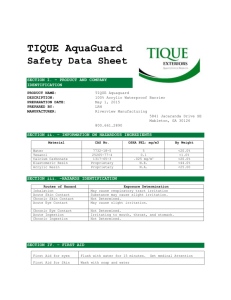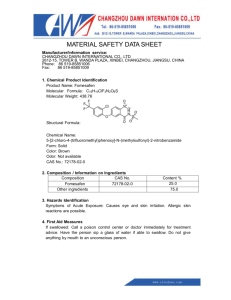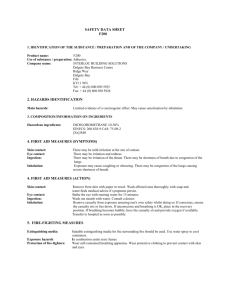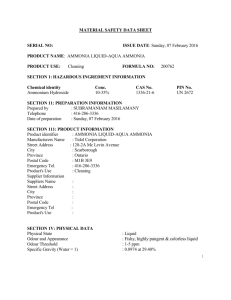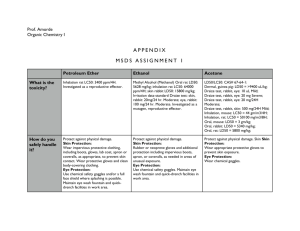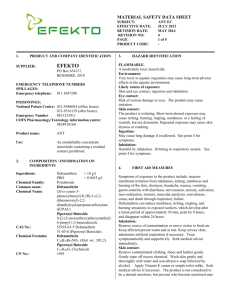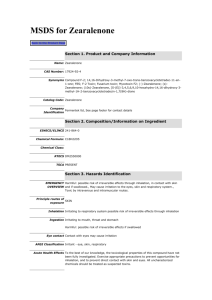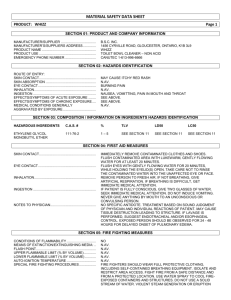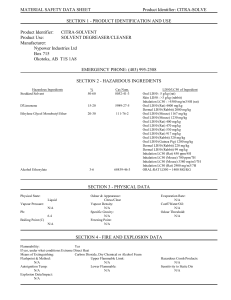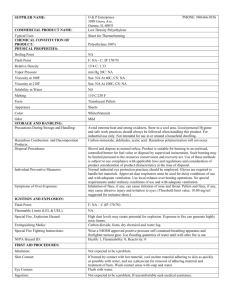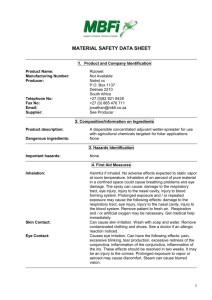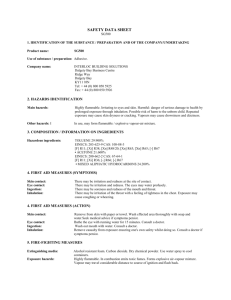grainfog - National Fumigants
advertisement
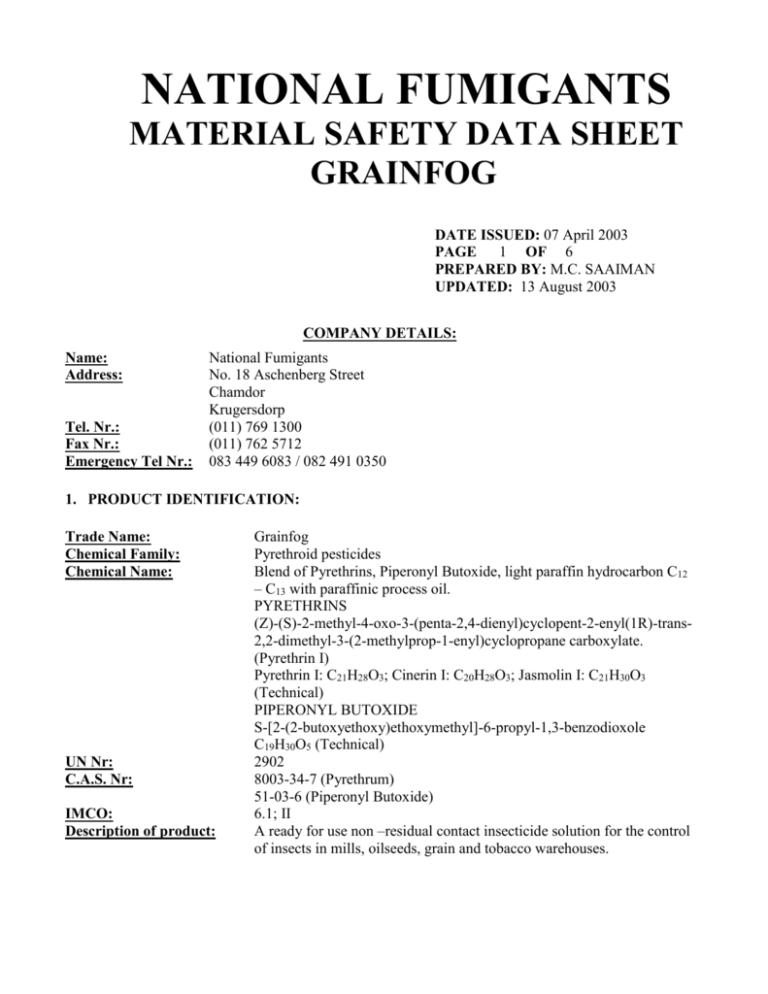
NATIONAL FUMIGANTS MATERIAL SAFETY DATA SHEET GRAINFOG DATE ISSUED: 07 April 2003 PAGE 1 OF 6 PREPARED BY: M.C. SAAIMAN UPDATED: 13 August 2003 COMPANY DETAILS: Name: Address: Tel. Nr.: Fax Nr.: Emergency Tel Nr.: National Fumigants No. 18 Aschenberg Street Chamdor Krugersdorp (011) 769 1300 (011) 762 5712 083 449 6083 / 082 491 0350 1. PRODUCT IDENTIFICATION: Trade Name: Chemical Family: Chemical Name: UN Nr: C.A.S. Nr: IMCO: Description of product: Grainfog Pyrethroid pesticides Blend of Pyrethrins, Piperonyl Butoxide, light paraffin hydrocarbon C12 – C13 with paraffinic process oil. PYRETHRINS (Z)-(S)-2-methyl-4-oxo-3-(penta-2,4-dienyl)cyclopent-2-enyl(1R)-trans2,2-dimethyl-3-(2-methylprop-1-enyl)cyclopropane carboxylate. (Pyrethrin I) Pyrethrin I: C21H28O3; Cinerin I: C20H28O3; Jasmolin I: C21H30O3 (Technical) PIPERONYL BUTOXIDE S-[2-(2-butoxyethoxy)ethoxymethyl]-6-propyl-1,3-benzodioxole C19H30O5 (Technical) 2902 8003-34-7 (Pyrethrum) 51-03-6 (Piperonyl Butoxide) 6.1; II A ready for use non –residual contact insecticide solution for the control of insects in mills, oilseeds, grain and tobacco warehouses. DATE ISSUED: 07 April 2003 PAGE 2 OF 6 PREPARED BY: M.C. SAAIMAN UPDATED: 13 August 2003 2. COMPOSITION: Hazardous Components: Pyrethrins Piperonyl Butoxide Paraffins (C12 –C13) Mineral Oil 0.5 % m /v 5.0 % m/v 30.0 % m/v 64.5 % m/v 3. PHYSICAL AND CHEMICAL CHARACTERISTICS: Appearance: Odour: Density @ 20 ºC: Solubility: Clear, yellowish liquid Perceptible 0.8223 kg / Miscible with water. 4. FIRE AND EXPLOSION HAZARD: Flash Point: Flammability: Auto ignition Temperature: Decomposition Temperature: Acute Hazards: Special fire fighting procedures: 81 º C Not available. Not available Not available Combustible liquid. Avoid all ignition sources. Apply cold water in order to cool containers exposed to danger. Water or foam may cause frothing. Water spray may be used to flush spills away from exposure. Prevent run off from fire control or dilution from entering streams, sewers, or drinking water supply. Special protective equipment: Do not breathe fumes. For fires in enclosed areas, fire fighters Must use self –contained breathing apparatus. Hazardous decomposition products: Carbon Monoxide. Fire extinguishing media: Carbon dioxide, foam, dry chemical powder. Unsuitable extinguishing media: Water jets. 5. REACTIVITY DATA: Stability: (thermal, light, etc.) Conditions to avoid: Stable. Extreme heat. The material is volatile. Prolonged storage at elevated temperatures may interfere with quality. Sensitive to light, air sensitive. Compatibility: Incompatible with strong oxidizing agents. Decomposes under alkaline (Materials to avoid) conditions. Hazardous decomposition products: Carbon monoxide will form when heated to decomposition; aldehydes in case off incomplete combustion. DATE ISSUED: 07 April 2003 PAGE 3 OF 6 PREPARED BY: M.C. SAAIMAN UPDATED: 13 August 2003 6. WARNINGS: Harmful if swallowed, by contact or inhalation. Store in a cool place, away from food, eating utensils, feedstuffs and drinking water. Keep out of reach of children, uninformed persons and animals. 7. HEALTH HAZARD DATA: (Acute Hazards & Symptoms) Potential Health effects and main symptoms: Acute of overexposure: Can produce central nervous system depression, which can lead to loss of co –ordination, impaired judgement, and, if exposure is prolonged, unconsciousness. Chronic of overexposure: Inhalation of vapour can produce headache, drowsiness, dizziness, anaesthetic effect and central nervous system depression. If exposure is prolonged, unconsciousness. Inhalation: Vapour may be irritant to mucous membranes and respiratory tract. Inhalation of vapour can result in headache, dizziness and possible nausea. Skin: Contact with skin will result in irritation. Will have a degreasing action on the skin. Repeated or prolonged skin contact may lead to irritant contact dermatitis. Eyes: May be irritant. Ingestion: Liquid may cause nausea, vomiting and diarrhoea, dizziness, narcosis and lung damage. 8. EXPOSURE CONTROLS / PERSONAL PROTECTION: Inhalation: Skin: Eyes: Ingestion: Adequate ventilation; Organic Vapour canister. Good personal hygiene. Wear protective equipment: clothing such as heavy rubber gloves, leather safety boots and impervious cotton or cotton blend overalls. PVC bib /rain suite should be worn when loading /of loading of product. PVC Face shields should be worn to protect eyes and face against splashes. Keep away from food and feedstuffs. Do not eat, drink or smoke whilst handling this product. Wash hands and face before eating and drinking. 9. FIRST AID MEASURES: Inhalation: Skin: Remove from exposure to fresh air, call physician, and administer oxygen if breathing is laboured. Wash contacted areas with soap and water. Remove contaminated clothing and wash before re –use. DATE ISSUED: 07 April 2003 PAGE 4 OF 6 PREPARED BY: M.C. SAAIMAN UPDATED: 13 August 2003 9. FIRST AID MEASURES: (continue) Eyes: Ingestion: Flush with copious amounts of water for 15 minutes. Obtain medical advice immediately. Do not induce vomiting: Rinse mouth with water. Have victim drink 240 –300 m water. If vomiting occurs, have victim lean forward to reduce risk of aspiration. Obtain medical attention. SEEK MEDICAL ADVICE PROMPTLY AND SHOW THIS SDS TO A MEDICAL PRACTITIONER 10. ACCIDENTAL RELEASE MEASURES: Notification procedures: Procedures if material is released or spilled: Eye /Face /Body: Hands: Methods for cleaning up: Small spill and leak: Large spill and leak: Environmental Precautions: Additional Instructions: Report spills as required to appropriate authorities. Absorb on fire retardant treated sawdust, diatomaceous earth, sand, peat sorb, etc. Shovel up and dispose of at an appropriate waste disposal facility, in accordance with current applicable laws and regulations, and product characteristics at time of disposal. Protective clothing (overall) should be worn. Use leather gloves as they provide heat insulation and do not absorb oil. Isolate spill area and stop leaks if possible without risk. Avoid inhalation of vapours. Collect and seal in properly labeled drums for disposal. Contain, prevent run off into drains, and waterways. Absorb with sand, earth or sawdust. Remove to safe area for disposal. Flush residue with large quantity of water. Use flameproof equipment. Prevent entry into waterways, sewers, drains, basements or confined areas. Spillage or uncontrolled discharges into water sources must be alerted to the Department of Water Affairs and other appropriate regulatory bodies. DATE ISSUED: 07 April 2003 PAGE 5 OF 6 PREPARED BY: M.C. SAAIMAN UPDATED: 13 August 2003 11. HANDLING AND STORAGE: Handling: Storage: Normal hygiene practices. Do not breathe gas, fumes, vapour or spray. Wear suitable respiratory equipment. Avoid contact with skin and eyes. Keep away from incompatibles. Store in a secure, dry, well –ventilated separate room, building or covered area. Do not store in open or unlabelled containers. Store away from strong oxidizing agents or combustible material. Keep containers closed at all times. Store at ambient temperatures. 12. DISPOSAL CONSIDERATION: Waste disposal: Product should be utilized completely to avoid disposal. If not possible, dispose of to supervised waste incineration plant, in accordance with current applicable laws and regulations. 13. TRANSPORTATION DATA: Hazardous Description Label: Keep away from foodstuff. Do not transport with food and feedstuffs. Petroleum Hydrocarbons 14. ECOTOXICOLOGY DATA: Toxic to bees, fish and wildlife. Keep away from waterways, sewers, drains, basements and confined spaces. Birds: Mallard ducks LD50: >10 000 mg /kg (Acute oral) Starlings LD50: > 100 mg /kg (Acute oral) Fish: Highly toxic Coho Salmon LC50: (96h) 30 mg / Channel catfish LC50: (96h) 114 mg / Bluegill sunfish LC50: 10 µg / Rainbow trout LC50: 5.2 µg / Carp LC50: (24h) 5.3 mg / Bees: Toxic to bees, but exhibits a repellent effect. LD50 : (oral) 22 ng /bee LD50: (contact) 130-290 ng /bee Daphnia: EC50: 12 µg / DATE ISSUED: 07 April 2003 PAGE 6 OF 6 PREPARED BY: M.C. SAAIMAN UPDATED: 13 August 2003 15. TOXICOLOGICAL INFORMATION: Carcinogenicity: Acute oral: Skin and eye: Inhalation: No adequate data available. LD50: Male rats: 2370 mg /kg Female rats: 1030 mg /kg Mice: 273-796 mg /kg Slightly irritant to skin and eyes; may cause dermatitis. LD50: Rats: > 1500 mg /kg Rabbits: 5000 mg /kg LC50: (4h) Rats: 3.4 mg / 16. REGULATORY INFORMATION: National Legislation: Registration numbers RSA: L3096
